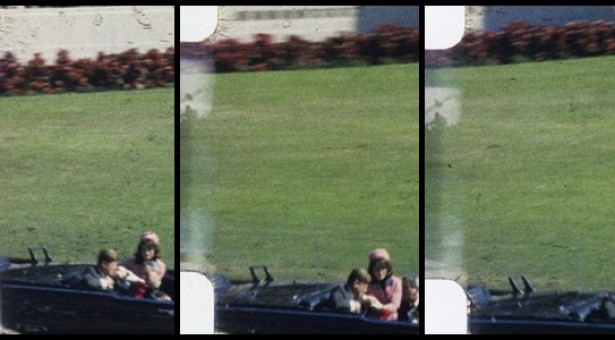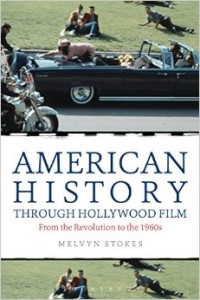American History through Hollywood Film

Česká verze textu je dostupná zde / Czech-language version of the text is available here
Melvyn Stokes tends to be identified mostly with publications focusing on the issue of film reception. Along with Richard Maltby, he edited five books with a set target to identify the audiences of Hollywood films both in the USA and abroad (e.g. Hollywood Spectatorship: Changing Perceptions of Cinema Audiences or Hollywood Abroad: Audiences and Cultural Exchange). In his capacity as a professor of American history at University College in London, he is also interested in the relationship of film and history. This is why, in his most recent book, Stokes attempted to capture the means by which Hollywood renders key events in American history.
The author explains upfront that he deems completeness and complexity to be unachievable within just one book. On that account, he decided to focus solely on a two century period of American history beginning with the War of Independence in the second half of 18th century up to the rebellious 1960s. The book therefore does not cover the colonial history or the Watergate scandal to name a few. The work is divided into ten chapters. While the first half is designed in a broader manner and works with numerous examples, the second one consists of more detailed analyses of one or two films. In total, Stokes touches on almost two hundred titles from the representatives of the early cinema up to such recent films as Django Unchained (2012) and Lincoln (2012).
Why occupy our minds with the representation of history in American cinema in the first place? As Stokes convincingly claims, films fundamentally influence – if not set – the way in which the general public perceives the past. Gone with the Wind (1939), for example, has determined for many years the way people thought of the Civil War era. In this sense, a spectacular film from producer David O. Selznick was more influential than written history or documentary films. At the same time it is however necessary to take into consideration that from the today’s point of view, Gone with the Wind, rather than the Civil War, exposes the time of its creation and exhibition, i.e. the turn of the 1930s and 1940s. We may ask how the social and political situation of that era influenced the presentation of the history and why a film emphasizes certain values and sidelines others, also many concepts can be analysed, including the portrayal of various demographic groups.
 The publication opens with a chapter covering the aforementioned American Revolution and the War of Independence. Among others, Stokes asks why this historic period wasn’t exploited more by the filmmakers and goes on to answer the question. According to Stokes, one of the core reasons was the key position of the British market as a primary outlet for Hollywood films. To put it in other words, Hollywood studios did not want to anger their British audience by returning to the mutual conflict from many years ago. In the second chapter the author describes the concept of slavery in American cinema and looks into the changing race stereotypes and the topic of race-mixing (miscegenation), which had been a taboo in film for a long time. The following chapter is the only one dedicated to a historical figure, namely to Abraham Lincoln, who has up to now appeared in approximately 150 Hollywood films. Stokes shows how filmmakers attempted to appropriate Lincoln’s mythical image and to what ideological purposes they used it. To the centre of attention get such films as The Birth of a Nation (1915), Abe Lincoln in Illinois (1940) by John Cromwell and Lincoln by Steven Spielberg. Chapters 4 and 5 then focus on the depiction of the Civil War and the subsequent restoration. Stokes even dedicates a few pages to the phenomenon of Ku Klux Klan in film. The key titles are once again The Birth of a Nation together with Gone with the Wind, Glory (1989) and Cold Mountain (2003).
The publication opens with a chapter covering the aforementioned American Revolution and the War of Independence. Among others, Stokes asks why this historic period wasn’t exploited more by the filmmakers and goes on to answer the question. According to Stokes, one of the core reasons was the key position of the British market as a primary outlet for Hollywood films. To put it in other words, Hollywood studios did not want to anger their British audience by returning to the mutual conflict from many years ago. In the second chapter the author describes the concept of slavery in American cinema and looks into the changing race stereotypes and the topic of race-mixing (miscegenation), which had been a taboo in film for a long time. The following chapter is the only one dedicated to a historical figure, namely to Abraham Lincoln, who has up to now appeared in approximately 150 Hollywood films. Stokes shows how filmmakers attempted to appropriate Lincoln’s mythical image and to what ideological purposes they used it. To the centre of attention get such films as The Birth of a Nation (1915), Abe Lincoln in Illinois (1940) by John Cromwell and Lincoln by Steven Spielberg. Chapters 4 and 5 then focus on the depiction of the Civil War and the subsequent restoration. Stokes even dedicates a few pages to the phenomenon of Ku Klux Klan in film. The key titles are once again The Birth of a Nation together with Gone with the Wind, Glory (1989) and Cold Mountain (2003).
As mentioned before, the remaining five chapters have a narrower scope and each deals with a certain issue using one or two films as an example. Dances with Wolves (1990) by Kevin Costner was opted for its depiction of Native Americans. Stoke takes notice of this film breaking some of the race stereotypes while helping to preserve others. The topic of the seventh chapter is immigration and its portrayal in an independent film Hester Street (1975) and Francis Ford Coppola’s blockbuster, The Godfather: Part II (1974). What follows is the Great Depression and its presentation in the adaptation of John Steinbeck’s novel The Grapes of Wrath (1940). Apart from other things, the author deals with the question why, for such a long time, Hollywood wouldn’t film the realistic story of the impact of the economic crisis and then, after 1947, stopped with the endeavour anew. One of the most remarkable chapters is that dedicated to the films depicting the Cold War era, particularly then the impact of the investigation of the House Un-American Activities Committee on the film industry itself. From the handful of the films dealing with this issue, Stokes chose two – The Way We Were (1973) and Guilty by Suspicion (1991). In the last section, the author analyses two titles “remembering” the 1960s – Mississippi Burning (1988), a film about racial unrest in American South, and controversial JFK (1991) depicting the investigation of the assassination of President John F. Kennedy.
Stoke’s book is without doubt beneficial for those interested in the relationship between film and history. Especially well it can serve to the students and teachers who come into contact with this issue on a regular basis. The only thing I would reproach it for is a certain imbalance and occasional inclination to a straightforward reflectionism. The first phenomenon can be demonstrated by comparing two neighbouring chapters on slavery and Abraham Lincoln (both partially overlapping in their scope). While the latter one is very well-done, proving the author’s in-depth familiarity with the topic (he himself wrote the book The Birth of a Nation; the chapter is furthermore based on already published journal article), the section dealing with slavery is here and there quite simplifying. For example, in the passage about miscegenation, Stokes claims that after 1956, when the Hollywood Production Code was rewritten, there were not many films made dealing with this up to then taboo topic. Susan Courtney, who dedicated her whole book to this issue, however states that during the 2nd half of 1950s we may observe almost an “eruption” of films on interracial relationships. While Stokes only quotes Raoul Walsh’s Band of Angles (1957), Courtney speaks of films such as Island in the Sun (1957), Night of the Quarter Moon (1959), The World, the Flesh and the Devil (1961) and many others.1 Regarding the second piece of criticism, the author’s reflectionism manifests itself in those passages viewing the films as one-sided “mirrors” of society while failing to take into consideration the industry determinants, to name just one. This can be spotted for example in the part dealing with the Civil War.
Despite the two remarks, American History through Hollywood Film is a very ïnspiring and readable book teaching the astute reader to think critically about the ways popular cinema presents historical events.
American History through Hollywood Film. From the Revolution to the 1960s
Melvyn Stokes
Bloomsbury
2013, 299 pages
You can order the book on the publishing house website here (e-book available here)
- COURTNEY, Susan. Hollywood Fantasies of Miscegenation. Spectacular Narratives of Gender and Race, 1903–1967. Princeton and Oxford: Princeton University Press, 2005, s. 193. [↩]






